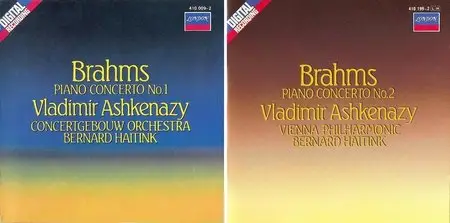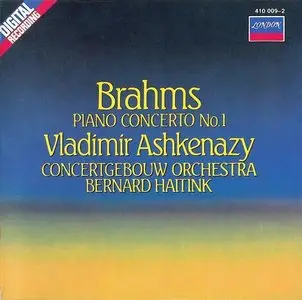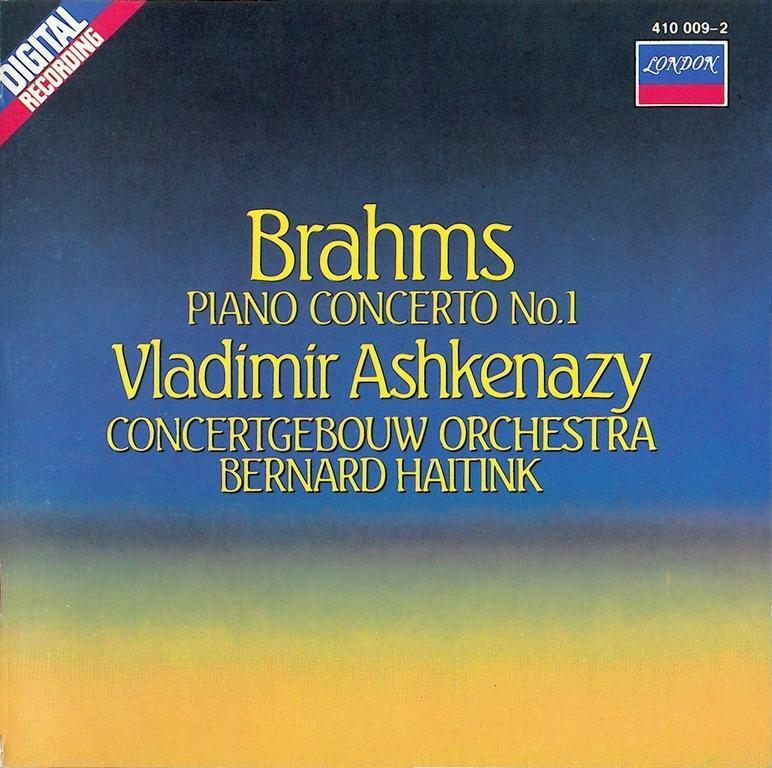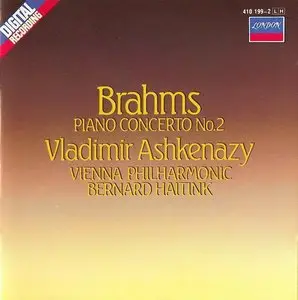Brahms · Piano Concertos Nos.1 & 2 · Vladimir Ashkenazy · Concertgebouw Orchestra · Vienna Philharmonic Orchestra · Bernard Haitink
APE+CUE 384 MB | Booklet | MP3 HQ 165 MB | Scans | EASY CD-DA 12 | No Log | 1983/1984
BRAHMS. Piano Concerto No 1 in D minor, Op 15. * Vladimir Ashkenazy (pno); Concertgebouw Orchestra / Bernard Haitink. Decca Compact
Disc ffJ4l0009-2. From SXDL7552(1/83).
The arrival of a Compact Disc some time after its LP version does give one the opportunity for more consideration of the performance. I do not want to detract at all seriously from the enthusiasm I showed when I first wrote about this recording in the January issue but as it came for review as long ago as November 1 have obviously had plenty of time to get to know it more intimately and one slight criticism has suggested itself. It is that I am now more conscious of Ashkenazy's frequent use of what is often called the agogic accent. 'Agogic' is a word I seldom use, since its meanings are several and the word is therefore imprecise; but it usually means a momentary hesitation before a note or chord, or a slight lingering on one. This is a perfectly legitimate weapon in a soloist's armoury, especially in Romantic music but it can become a mannerism if used excessively and once you become conscious of a mannerism it can be slightly tiresome. It does not worry me greatly as Ashkenazy uses it but I would not have minded if he had used it less.
All the same, I still think it a very fine performance, to the extent that I enjoy it enormously each time I hear it; and that alone would make me choose the CD version, for after only a few playings of my LP the surface is already slightly damaged, though I treat my records with the utmost care, and this is one I shall certainly want to enjoy very often, so that it is marvellous to sit back with the assurance that no extraneous noises will irritate me.
Opinions have differed about the quality of the piano tone but I find it perfectly good on both LP and CD. It has been suggested that the piano is poorly tuned (I understand that Ashkenazy had to use the 'resident' one in the Concertgebouw) but the moments of questionable tuning are fleeting and do not seriously detract from my overall pleasure. The LP sound was bright and clear. The CD is the same and slightly improves on the reproduction of the orchestra, giving it even more detail in the middle register: but the basic reason I should choose it is, as I said, because this is a version of the concerto I shall want to play very often, and my second thoughts on the playing should be read in conjunction with the splendid qualities I noted in my review of the LP disc.
Gramophone, July 1983 Page 33
BRAHMS. Piano Concerto No 2 in B flat major, Op. 83, Vladimir Ashkenazy (pno). Vienna Philharmonic Orchestra / Bernard Haitink.
Dacca digital (f) 410 1991; LEI 410 199-4: Compact Disc version 410199-2 (to be reviewed later).
Selected comparisons
Gilels, BPO, Jochum (12/72) (4/81)(R) 2542151
Bishop-Kovacevich, LSO, C Davis (12/81) 9500682
Robert Layton reviewed the alternative suggestions listed above—Gilds on DG and BishopKovacesich on Philips—as well as a considerable number of other performances which he mentioned with approval, and it was clear that he felt quite unable to say which was 'the best—that thoughtless question that reviewers are quite often asked. This concerto has indeed done well on record.
Ashkenazy's record of the First Concerto (Decca SXDL7552, 1/83) had two slight flaws in an otherwise superb account, both of which have disappeared in No. 2. The first was an indifferent piano: this showed mainly in the first movement. The second was a too frequent use of agogic hesitations which became so noticeable that they were a mannerism. They also seem to have disappeared; and when there is a slight use of them they are done so naturally that now they seem absolutely right. So this is a superb performance on the grandest scale, supported by Haitink in the same style, with the VPO on its finest form and in a digital recording of great presence—one of Decca's best.
The opening bars, showing Ashkenazy at his most poetical, promise well, and that promise is sustained by Haitink through the opening tutti. The whole concerto goes through such a range of moods and both artists convey them with superb response to their changes; from the greatest strength (note the power of the three accented chords in bars 244-5 from Haitink) to a quite different thing, the way the flute and oboe play the two notes after the rest in bar 193, exactly matching the character with which the soloist plays them a bar latei'—this performance has been properly rehearsed. In the slow movement there is the utmost magic in the pit) Adagio.
The finale is taken at a very deliberate Allegretto and is really grazioso; of course, they have to move it on a bit here and there, but that matters little. The only thing I would add is that in the Scherzo Haitink slows down too much and too obviously for my liking at the string passage in octaves from bar 43. Surely you can be Iranquillo e do/ce, yet not change the tempo so drastically. But that is a small quibble about a record which on all accounts must rank at least among the greatest. T. H.
Gramophone, April 1984 Page 37
Download Brahms Piano Concertos 1 & 2 APE+CUE | RS 1 | RS 2 | RS 3 (rename folder name Ashkenazy)
MP3 HQ LAME 3.98 -V0 Stereo | RS 1
pw: aire







